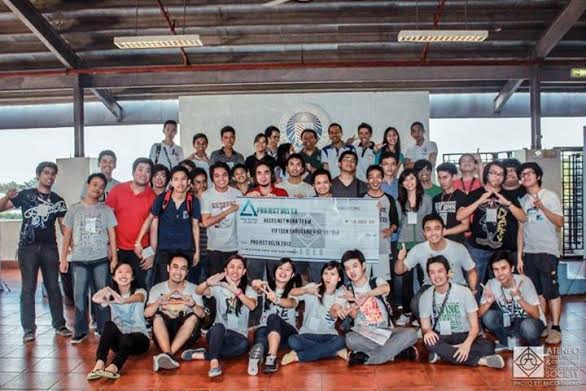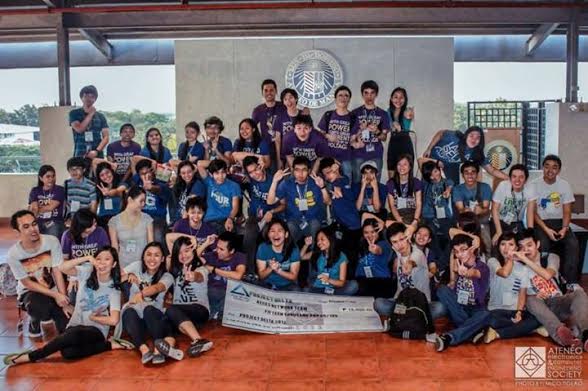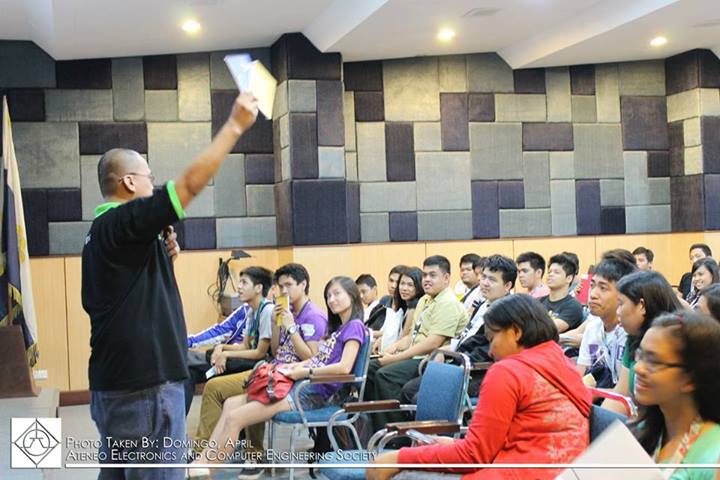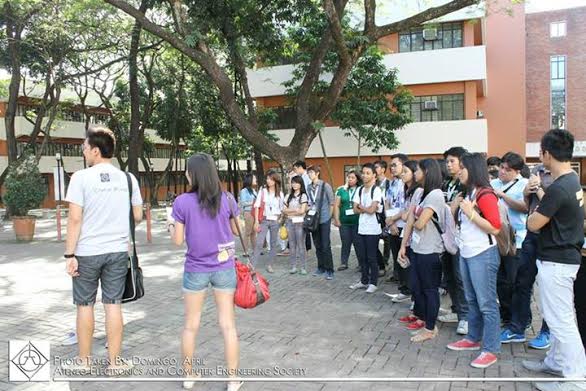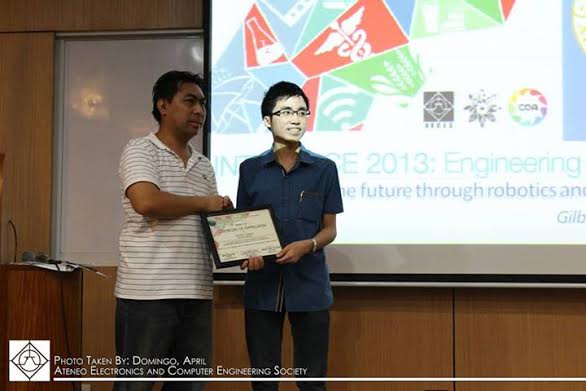INTERFACE 2013: “Engineering the Future” by the Ateneo Electronics and Computer Engineering Society 
INTERFACE 2013: “Engineering the Future” by the Ateneo Electronics and Computer Engineering Society
Welcoming a blast of participants from different universities last Saturday, 16th of November 2013, has been a leap for the Ateneo ECCE (Electronics, Computer and Communications Engineering) Community. “Engineering the future” as the tagline of the event says, started within a day, with one goal and declaring one champion. Interface 2013 is the annual ECCE celebration event of the Ateneo Electronics and Computer Engineering Society (AECES), the student organization catering to electronics and computer engineering majors of the Ateneo de Manila University.
On the Audacity towards Technological Innovation
The Y Generation of visionary leaders and innovators has built a stable and trusted foundation in this event through a series of parallel talks. These talks outstandingly challenged the traditional industry standards to strengthen their competitive edge and asked one goal for everyone, that is, to continuously raise the bar for our industries, businesses, even ourselves and the whole of humanity through exploring innovative ways to encourage the other stakeholders to do the same. With the span of various industry segments, this has been an opportunity for the participants to craft and design the process and realize their role in nation building.
A good deal of the program was an accumulation of knowledge and new things brought by the speakers of the event, who apparently ranged from academicians and innovators to industry leaders and pioneers. The day was ultimately perfect for several kinds of engineers, as audience participants got to hear what they need to hear on very important topics in today’s era of technology and society. The day started with Dr. Fabian Dayrit’s speech on innovation in the Philippine setting, especially as Ateneo Innovation Center continues to exercise innovation in doing what it takes to resolve current local issues.
The morning parallel talks were of two sets, one set took place at the Social Science Conference rooms and the other at the Ching Tan Room at the Ateneo de Manila University School of Management. Inside the Social Science Conference rooms, the participants heard from Engr. Gerrald Mateo, a field applications engineer and the program coordinator for Planet NI, the innovative developments in the National Instruments in addressing science, technology, engineering, and mathematics (STEM) education and improving small-to-medium scale businesses. The morning proceeded with Canon Information Technologies Inc.’s Mr. Rodel Escaros, manager for the human resources, and presented the techonological innovations within the Canon group and the expectations that the students will be having once they step up towards the technical industry. Lastly, Excel Review’s Engr. Mark Anthony Melendres provided a presentation on IPv6, as cellular systems evolve and converge towards this technology.
The other set of talks which took place at the Ching Tan room were no less a discussion on technological innovations and services. PLDT Innolab’s Danilo June Francisco provided a presentation on their center’s exploration towards applications of ICT and communication technologies for small and medium businesses and other projects such as disaster response. Afterwards, Macquarie’s Lawrence Guinto presented their company’s means to provide finance management via an IT solution known as Vblock. Lastly, Ateneo’s very own 5th year ECE students, Alyssa Tricia Vintola and Lorenz Ray Payonga, shared their victory and award-winning project to the Schneider Electric “Go Green” challenge, the “Oscillohump”, its concept and business plan.
As the morning program ended, the participants prepped up for the excitement that was about to commence in the afternoon program. Simultaneous with the Mission Nabla, this year’s amazing race competition for the participating college students, are another set of similarly technological talks. The afternoon started with Accenture’s Camlon Asuncion and his presentation on management and analysis of big data. Afterwards, the entire Faura Audio-Visual room listened to Solenergy Systems Inc.’s CEO, Tom Peebles, as he discussed the solar power industry in the Philippines and the smarter solutions to combat the issues existing in the said industry. As Mission Nabla was launched, delegates listened to FELTA Multimedia Inc.’s Gilbert Zamora and his presentation on the significance and practical applications of robotics. Lastly, Bryan Lao, an assistant faculty member at the Department of Electronics, Computer, and Communications Engineering of the Ateneo de Manila University presented the various engineering projects and programs that the university offers.
Divergence in engineering student dynamics
Nabla denotes the gradient function of a scalar field in vector calculus, an indicative vector field that shows the direction of the highest rate of increment of a particular scalar field. Simply, as with the derivative of a function, the gradient determines the slope or the fluctuation of a quantity in space.
In parallel with the technical denotation, Mission Nabla, as a competitive activity, aims to channel the potential of engineering-oriented participants, to bring about that directive affinity for excellence and critical-mindedness. Mission Nabla is about a community of engineering-minded people, moving as one assembly of agents for the benefit of making sure that engineering as a science is appreciated, celebrated, and credited in the society.
Eight mighty teams competed in the Mission Nabla, ultimate amazing race for the engineering student. Each team represents and upholds the engineering skills honed in their schools. From the Adamson University are two teams, aptly AdU 1 and AdU 2; from the Bulacan State University are two teams as well, BulSU 1 and BulSU 2; from the Technological Institute of the Philippines – Manila campus are two teams, TIP-Manila A and TIP-Manila B; and one team each from the Technological University of the Philippines – Manila, TUP-Manila, and from the Engineering Radio Guild of the University of the Philippines, UP ERG. Two hours and a half of circling around the campus was just one part of the challenge; the real deal was what mindboggling challenge waits at every station. The challenges range from DC analysis problems to experimental oscilloscope reading, and from layering liquids to Arduino programming.
The mechanics of the race is simple: each team is given an initial number of tokens. In order to accomplish a challenge in every station, each team must bet a certain number of tokens. If the challenge is successfully won over, the team receives their reward of equal number of tokens to the betted tokens. Otherwise they are to lose their bets and give up their bet tokens. But for every station are a maximum number of tokens to bet, set “randomly”. The team who collects the most number of tokens after two hours and a half is declared the champion, followed by the second place and the third place.
At the end of the race, BulSU 1 bagged championships and cash prize of P 5000, with 58 tokens at the end of the race. AdU 2 took home the second place prize and P 2000 cash prize, with 43 tokens, whilst UP ERG came as third place and was awarded of P 1000, with 38 tokens.
Interface 2013 officially closed with a total of 107 participants, 77 of which were delegates while 30 were 10 participating groups-of-three to Mission Nabla. A long day, a favourable weather, Interface 2013 was but a reminder that the journey towards becoming an engineer is a continual path of crossroads: strategies and decisions are demanding, and possibilities are never-ending, but so are experiences, friendships, collaborations, and opportunities.
